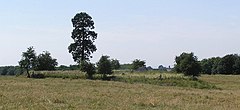High Worsall
| High Worsall | |
|---|---|
 Site of the deserted village | |
Location within North Yorkshire | |
| OS grid reference | NZ387093 |
| Civil parish |
|
| Unitary authority | |
| Ceremonial county | |
| Region | |
| Country | England |
| Sovereign state | United Kingdom |
| Post town | YARM |
| Postcode district | TS15 |
| Police | North Yorkshire |
| Fire | North Yorkshire |
| Ambulance | Yorkshire |
High Worsall is a hamlet and civil parish in North Yorkshire, England. It is near Low Worsall and 4 miles (6.4 km) west of Yarm. The population of the parish was estimated at 40 in 2010.[1] The population remained at less than 100 at the 2011 Census, so details were included in the civil parish of Low Worsall. However, in 2015, North Yorkshire County Council estimated the hamlet to have 40 people living there in 2015.[2]
Both High and Low Worsall are mentioned in the Domesday Book,[3] and the first element derives from an Old English personal name (Wyrc) and the location of the villages in the nook of land of the River Tees provides the second element of the name.[4][5] The area contains evidence of a deserted medieval village, featured on Time Team in the late 1990s.[6]
A chapel dedicated to St John was built in the village c. 1710, which was used up until 1894, when a church was built in Low Worsall. The churchyard was still the location of burials until at least 1957.[7][8][9]
High Worsall was the highest tidal point on the River Tees until the opening of the Tees Barrage in 1995.[10][11][12]
References
[edit]- ^ "Population Estimates". North Yorkshire County Council. 2010. Archived from the original on 13 January 2012. Retrieved 27 June 2013.
- ^ "2015 Population Estimates Parishes" (PDF). northyorks.gov.uk. December 2016. p. 11. Archived from the original (PDF) on 4 June 2022. Retrieved 21 May 2023.
- ^ "[High] Worsall | Domesday Book". opendomesday.org. Retrieved 21 May 2023.
- ^ Smith, A. H. (1979) [1928]. The Place Names of the North Riding of Yorkshire. English Place Name Society. p. 174. OCLC 19714705.
- ^ Ekwall, Eilert (1960). The concise Oxford dictionary of English place-names (4 ed.). Oxford: Oxford University Press. p. 535. ISBN 0-19-869103-3.
- ^ "Daniels, R. (2009). The deserted medieval village of High Worsall, North Yorkshire. Durham Archaeological Journal 18. Vol 18, pp. 67-98". archaeologydataservice.ac.uk. Retrieved 21 May 2023.
- ^ Pevsner, Nikolaus (2002). Yorkshire, the North Riding. Yale University Press. p. 402. ISBN 0-300-09665-8.
- ^ "Genuki: In 1822, the following places were in the Parish of Northallerton:, Yorkshire (North Riding)". www.genuki.org.uk. Retrieved 21 May 2023.
- ^ Historic England. "Medieval settlement and associated field system and post-medieval chapel, adjacent to Manor House Farm (1019065)". National Heritage List for England. Retrieved 21 May 2023.
- ^ Moorsom, Norman (1986). The Book of Middlesbrough. Buckingham: Barracuda Books. p. 27. ISBN 0860232743.
- ^ "River flows to a cleaner future". The Times. No. 64276. 10 March 1992. p. 27. ISSN 0140-0460.
- ^ "Today's royal engagements". The Times. No. 65321. 17 July 1995. p. 20. ISSN 0140-0460.

